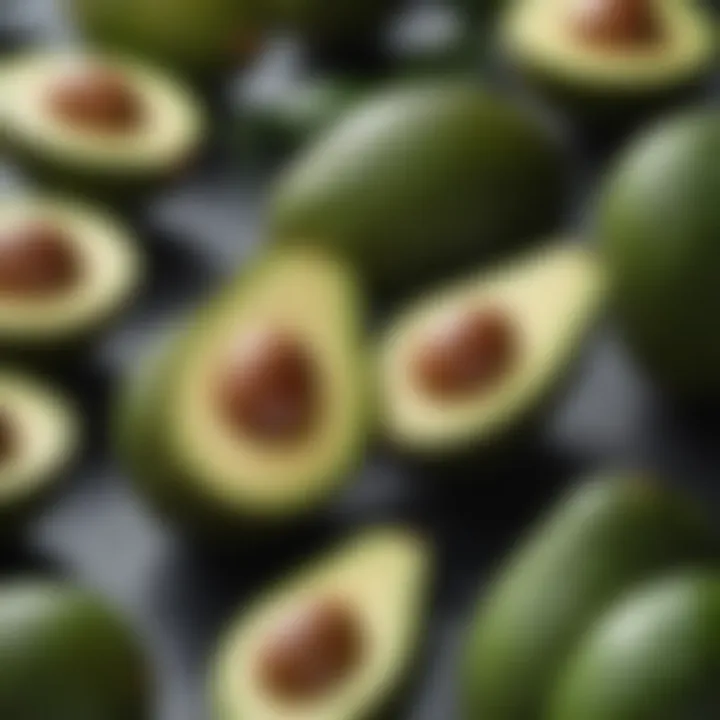Mastering Avocado Ripening: Techniques & Tips


Intro
Avocados are an essential component in many cuisines around the world. Understanding how to ripen them properly can greatly enhance their flavor and texture, whether used in salads, spreads, or main dishes. This guide aims to clarify the methods of ripening avocados, focusing on natural and artificial techniques.
Ripening is not merely a waiting game; it involves a series of factors such as temperature, ethylene gas, and the avocado's own maturity. With knowledge of these elements, anyone can master the art of achieving perfectly ripe avocados. This guide intends to serve as a roadmap for readers, offering practical tips and comprehensive insights.
Whether you are a home cook or a culinary enthusiast, this information will elevate your cooking and enjoyment of avocados.
Key Points to Discuss
- Natural Ripening: Identifying optimal conditions.
- Artificial Techniques: Quick ripening methods.
- Factors Influencing Ripening: Temperature and environment effects.
- Practical Tips: Do’s and don’ts for ripening avocados.
Understanding Avocado Ripening
Understanding avocado ripening is foundational for anyone looking to enjoy this fruit at its peak flavor and texture. The ripening process determines how we experience avocados, whether in a salad, smeared on toast, or as guacamole. Knowing how to manage ripening effectively allows consumers to select and handle avocados in a way that maximizes their culinary use and reduces waste.
Avocados are unique fruits that do not ripen in the same manner as many others. They ripen post-harvest, so the time between purchase and consumption can become critical. Understanding how to control this process means that cooks can anticipate when their avocados will be ready, coordinating meal prep and events more efficiently. This knowledge is not only beneficial for personal use but can also assist those in the food business, ensuring they serve customers with only the best quality avocados.
The Science Behind Avocado Ripening
Ripening is a natural process involving a series of biochemical changes that affect the fruit's color, texture, and taste. For avocados, this process is triggered by a hormone called ethylene. Ethylene is a gaseous plant hormone that plays a crucial role in the ripening of many fruits. Once avocados reach optimum ripeness, their flesh becomes buttery and creamy, inviting culinary creativity.
The science of ripening is deeply tied to how avocados interact with their environment. Factors such as temperature, humidity, and storage conditions can influence the ripening rate. Cooler temperatures typically slow down the process, while warmer ones can accelerate it.
Ethylene's Role in the Ripening Process
Ethylene stands out as a central player in avocado ripening. It acts as a signaling molecule that triggers genetic expressions and enzyme activities linked to the ripening process. As avocados are exposed to this gas, they begin to soften, develop sugars, and lose bitterness.
"Ethylene is key in determining how fast avocados go from hard and inedible to soft and delightful."
Many fruits release ethylene naturally; thus, they can influence each other's ripening. Placing avocados in proximity to ethylene-producing fruits like bananas or apples can significantly speed up ripening. This phenomenon provides a straightforward method to ensure your avocados reach culinary readiness when you need them. Understanding this relationship makes it easier to plan meals and manage food resources effectively.
Overall, understanding the intricate processes behind avocado ripening can enhance the appreciation and application of this versatile fruit. By considering the roles of ethylene and environmental conditions, consumers can take command of their avocado experience.
Identifying the Perfect Avocado
Identifying the right avocado is crucial for anyone who wants to enjoy the rich, creamy texture and taste of this fruit. An avocado can be an excellent addition to various dishes, but its flavor and experience transform based on its ripeness. Understanding how to spot a ripe avocado allows you to avoid disappointment and elevate your culinary practices.
Choosing an avocado that is at the right stage of ripeness ensures that you make the most of its unique characteristics. Ripe avocados are soft yet firm, providing the perfect balance for spreading or slicing. If you are not careful, selecting an under-ripe avocado can lead to a disappointing experience when cooking or creating your favorite meals. Similarly, an overly ripe avocado might have brown spots or mushy texture, which is also undesirable. In this section, we will delve into the specific characteristics of a ripe avocado, followed by best practices for selecting avocados at the market.
Characteristics of a Ripe Avocado
A ripe avocado has distinct physical traits that indicate its readiness for consumption. When examining an avocado for ripeness, pay attention to the following aspects:
- Color: The skin of a ripe avocado typically ranges from deep green to nearly black, depending on the variety. The popular Hass avocado, for instance, darkens as it ripens.
- Texture: A ripe avocado should feel slightly bumpy. When you press it gently with your fingers, it should yield slightly to pressure without feeling overly soft or mushy.
- Shape: The ideal shape of a ripe avocado is somewhat oval. Flat or irregular shapes may indicate under-ripeness or issues during growth.
- Stem Test: Removing the small stem at the top of the avocado can offer insight into ripeness. If it comes off easily and reveals green underneath, the avocado is ripe. If it’s difficult to remove or shows brown, it’s likely overripe.


Overall, these characteristics collectively help in assessing the avocado’s readiness.
Choosing Avocados at the Market
Selecting avocados at the market can be an art in itself. Here are some tips that can help you make informed choices:
- Inspect the Display: Often, avocados are displayed in bins. You can assess their overall appearance, checking for any visible damage or bruising. Choose avocados that are free from dark blemishes.
- Feel for Firmness: When you pick an avocado, gently squeeze it. You want to find ones that give slightly to pressure. Avoid any that are too hard, as these are likely not ripe, or too soft, which may indicate overripeness.
- Ask Questions: If available, do not hesitate to ask the store staff about the ripening status of the avocados. They can provide helpful insights on when they were received and their expected ripeness.
- Buying in Batches: If you plan to use avocados throughout the week, consider buying a mix of ripe and unripe ones. This ensures you have ripe avocados ready for immediate use while providing time for the others to ripen for later use.
"Selecting the right avocado is not just about ripeness. It is about timing your culinary needs effectively."
Making smart choices at the grocery store can drastically impact your experience with avocados and their subsequent use in your cooking. By understanding what to look for, you can enhance your culinary creativity while enjoying fresh, delicious avocados.
Natural Ripening Techniques
Natural ripening techniques play a crucial role in ensuring the optimal flavor and texture of avocados. Understanding these methods can significantly improve your ability to enjoy this beloved fruit at its peak. Natural methods are often more gentle on the fruit and can result in a more consistent ripening process. They require minimal resources and help maintain the avocado's integrity, promoting a fresher taste and better nutritional profile.
Ripening at Room Temperature
Ripening avocados at room temperature is perhaps the simplest and most common method. This natural approach allows avocados to ripen gradually by exposing them to the ambient conditions of your kitchen. When stored at room temperature, avocados typically take between four to six days to fully ripen, depending on their initial firmness.
This method is advantageous because it requires no special tools or ingredients, making it accessible for everyone. Simply place the avocados on a countertop, away from direct sunlight, and check them periodically. The gentle warmth of your home promotes the production of ethylene gas, which is essential for ripening.
Using a Paper Bag
Another effective technique for ripening avocados involves the use of a paper bag. This method enhances the natural ripening process by trapping ethylene gas emitted by the avocados themselves. To utilize this method, place unripe avocados in a brown paper bag, fold the top to seal it, and set it aside at room temperature.
The closed environment accelerates the accumulation of ethylene gas, resulting in faster ripening compared to simply leaving them out in the open. Most avocados will ripen within one to three days using this method. It is particularly useful if you need to hasten the ripening process for immediate use, but caution should be exercised as it can also lead to over-ripening if not monitored closely.
Ripening with Other Fruits
Ripening avocados alongside other fruits can also yield satisfactory results. Certain fruits, such as bananas and apples, emit high levels of ethylene gas, which can expedite the ripening of avocados when placed together in a bowl or bag. This method leverages the natural gas output from these fruits to enhance the ripening of avocados.
To use this method, place one or two ripe bananas or apples in the same container as the unripe avocados. In this way, not only do you gain the benefit of an amplified ethylene effect, but you also have an opportunity to enjoy additional fruits that can ripen at the same time.
This technique may take anywhere from one to four days, depending on the initial ripeness of the accompanying fruits.
Artificial Ripening Methods
Artificial ripening methods serve as essential tools when it comes to ensuring avocados reach optimal ripeness in a controlled manner. Many cooks and food enthusiasts encounter avocados that are not yet ready for use, leading to frustration in meal preparations. Understanding these methods can greatly influence the timeline of your cooking, bringing convenience and efficiency. Moreover, mastering artificial techniques can help prevent the sour disappointment of serving underripe fruits.
Using Heat To Accelerate Ripening
Heat application is one of the most common artificial ripening methods for avocados. This technique takes advantage of the fruit's natural biochemical processes. When exposed to warmth, avocados stimulate ethylene production, which in turn accelerates ripening.
The ideal temperature for ripening avocados is generally around 75 to 85 degrees Fahrenheit. You can utilize various sources, such as an oven or even a heated area in your kitchen. Here’s how you can implement this method effectively:
- Select your avocados. Choose those that are firm but not completely hard.
- Wrap in foil. Wrap the avocados in aluminum foil. This retains heat and could speed up the process more effectively.
- Place in warm area. Put the wrapped avocados in a warm location, keeping an eye on them to prevent overheating.
- Check regularly. It’s important to monitor ripeness every few hours to gauge progress and avoid over-ripening.


This method can yield a ripe fruit in as little as 24 hours, depending on the starting firmness. However, using excessive heat or leaving them too long can result in undesirable changes in taste and texture.
Microwave Method for Quick Ripening
For those in a hurry, the microwave method offers a quick solution for ripening avocados. This technique is effective but does carry some risk, as microwaving can affect the evenness of ripening.
To use this method:
- Wrap the avocado. Start by wrapping the avocado in a microwave-safe paper towel. This helps retain moisture, reducing the chances of cooking the flesh.
- Microwave in intervals. Heat the avocado on medium power for 30 seconds at a time. It’s best to check after each interval.
- Assess the ripeness. After a few rounds, gently press the avocado. If it yields slightly, it is ready to use.
Caution: This method may lead to uneven ripening or result in a slightly altered flavor. Use it only as a last resort when time is of the essence.
Utilizing artificial methods for ripening avocados can significantly assist in culinary preparations. However, it’s critical to monitor the progress closely, as too much heat can compromise the fruit’s desirable qualities.
Monitoring Ripeness
Understanding how to effectively monitor the ripeness of an avocado is critical for achieving the perfect texture and flavor. If avocados are consumed too early, they will be hard and lack the buttery taste that many appreciate. On the other hand, allowing them to overripen can result in an unpleasant mushiness. Thus, monitoring ripeness serves as a bridge between the natural ripening process and the desired culinary outcome. Key elements to consider are physical checks, timing, and observation of external signs that indicate readiness for consumption.
Physical Checks for Ripeness
Finger Pressure Test
The Finger Pressure Test is a straightforward and intuitive way to gauge whether an avocado has reached ideal ripeness. This method involves gently pressing the avocado with your fingers to check for softness. A ripe avocado should yield slightly to pressure, indicating a creamy interior. This test is popular due to its simplicity, making it accessible for most people.
A key characteristic of this test is that it provides immediate feedback on the fruit's condition. However, care must be taken, as excessive pressure can damage the skin and lead to bruising, which affects flavor later. This technique also allows for quick checks in the market or at home. The main advantage is that it offers a tactile sense of readiness without elaborate tools required.
Stem Test
The Stem Test presents another effective method for assessing avocado ripeness. By gently removing the small stem at the top of the avocado, one can examine the color underneath. If the color is green, it usually indicates that the avocado is ripe or very close to it. If it is brown, the avocado may be overripe. This method is beneficial due to its non-invasive nature; it requires merely lifting a small part of the fruit and does not risk bruising.
A distinctive feature of the Stem Test is the ability to visually assess the ripeness, providing an additional layer of confirmation. However, this test does require a slight level of dexterity and may not be as easily performed in a market setting compared to the Finger Pressure Test. Despite its disadvantages, many consider this method reliable for ensuring a better quality eating experience.
Timing Your Check
Timing is essential when monitoring avocado ripeness. One should regularly check the avocados, especially if they are kept at room temperature. Checking too frequently can lead to impatience or overcorrecting the ripening process. Ideally, a daily check during the expected ripening period allows one to grasp the pace at which the fruit is softening. By establishing a regular routine, it becomes easier to engage with the continuity of the ripening process, leading to better decision-making regarding when to use or store the fruit.
In summary, consistent monitoring of ripeness through simple physical checks and thoughtful timing aids in achieving the best culinary outcomes for avocados.
Post-Ripening Care
Post-ripening care is crucial for maintaining the quality and taste of ripe avocados. Once avocados reach their optimal ripeness, proper storage and usage will ensure they remain delicious for a longer period. Ignoring these steps can lead to spoilage and waste, which is not ideal for any culinary endeavor. Understanding the best practices for post-ripening care allows both casual cooks and enthusiastic food lovers to fully enjoy the flavors and textures that ripe avocados offer.
Storing Ripe Avocados
Storing ripe avocados requires some thought to extend their freshness. Here are some important considerations:
- Refrigeration: Avocados can be stored in the refrigerator once they have ripened. This lowers the temperature and slows down the ripening process. Generally, whole ripened avocados can last up to a week when stored in the fridge.
- Cut Avocados: For avocados that have been cut, it is essential to minimize exposure to air. Applying lemon juice or vinegar on the cut surface can help prevent browning. Wrap the avocado tightly in plastic wrap or place it in an airtight container before refrigerating. They can last about one to two days in this state.
- Temperature Control: Always maintain a consistent temperature. Avoid storing ripe avocados in places that experience heat or sunlight, as this can hasten spoilage.


Using Ripe Avocados
Using ripe avocados is about more than just enjoying their immediate flavor; it also involves maximizing their culinary potential. When avocados are at their best, there are various ways to incorporate them into your diet:
- Salads: Diced ripe avocados add creaminess to salads. They complement ingredients like tomatoes, onions, and lime well.
- Spread or Dip: A ripe avocado can be easily mashed to create guacamole or spreads for sandwiches. Adding spices can enhance the flavor significantly.
- Toppings: Use ripe avocado slices as toppings for toasts. Nutrition-packed and satisfying, this is a simple yet elegant dish.
- In Smoothies: Blending ripe avocados into smoothies provides a rich and silky texture. Their subtle flavor pairs nicely with fruits.
In summary, post-ripening care is vital for keeping your avocados fresh and delicious. By understanding proper storage methods and ways to use ripe avocados in various dishes, you enhance your culinary experience and reduce waste.
Common Mistakes in Avocado Ripening
Understanding common mistakes in avocado ripening is essential for enhancing your culinary experiences. Many home cooks and food enthusiasts struggle with achieving the perfect ripeness, resulting in avocados that are either too firm or overly mushy to use. By recognizing and avoiding these common mistakes, you can ensure that each avocado you choose to ripen meets your desired texture and flavor. This section will address the two primary problems: over-ripening and under-ripening.
Over-Ripening Issues
Over-ripening occurs when avocados are left to ripen beyond their ideal state. When avocados are subjected to this condition, they can develop brown spots and a mushy texture, making them undesirable for many recipes. The flavor also deteriorates, often becoming overly sweet and less creamy. Overly ripe avocados may also not hold their shape when sliced, which is an important consideration for dishes like salads or sandwiches.
To avoid over-ripening, it’s important to monitor the ripening process closely. Here are a few effective strategies:
- Keep Track of Time: Regularly check your avocados, ideally every day, to assess their level of ripeness.
- Use Temperature Wisely: Store avocados at room temperature for ripening but refrigerate them once they reach peak ripeness. This slows the process significantly.
- Avoid Sealing in Plastic: While it may seem beneficial to wrap avocados in plastic to trap ethylene gas, this can lead to quicker spoilage.
In summary, recognizing the signs of over-ripening and implementing proactive measures are key to avoiding this issue.
Under-Ripening Problems
Under-ripening happens when avocados are removed from their ripening environment too soon. This leads to firm, unyielding fruit that lacks the signature buttery texture. Underripe avocados often have a grassy taste and do not lend themselves well to dishes that require a creamy consistency.
To ensure your avocados receive adequate time to ripen, consider the following:
- Patience Is Key: Allow sufficient time for naturally ripening, especially for harder varieties that tend to take longer.
- Room Temperature: A warm environment promotes ripening. Placing avocados in a bowl on your kitchen counter will support this process.
- Check Weekly: Sometimes, it may take a few days longer than anticipated. Regular checks can help determine the best moment to eat them.
In essence, avoiding these common mistakes requires awareness and attention. Both over-ripening and under-ripening can significantly impact your enjoyment and, ultimately, your cooking. Taking care to monitor the ripening process will elevate the quality of your dishes using avocados.
Frequently Asked Questions
In any culinary endeavor, understanding commonly asked questions can significantly streamline the process. This section highlights key queries regarding avocado ripening, providing clarity on concerns that many face. Addressing these doubts allows readers to not only gain confidence in their skills but also to make informed decisions that enhance their culinary practices. Common questions lead to insights that demystify the ripening journey, making it simpler and more effective. The answers here aim to shed light on specific elements that are crucial in obtaining perfectly ripened avocados.
How long does it take to ripen an avocado?
Ripening time for avocados can vary, influenced by several factors such as the initial ripeness at the point of purchase and environmental conditions. Generally, at room temperature, avocados can take anywhere from two to seven days to ripen. If one uses techniques like placing them in a paper bag or with other ethylene-producing fruits, this process may take only one to three days. It is crucial to monitor the fruit closely to avoid over-ripening, which could lead to spoilage.
- Start checking the avocados after two days if they are in a paper bag.
- If left at room temperature and unbagged, seven days might be necessary before they soften adequately.
The patience required in this process should be matched with vigilance, as time can change their texture rapidly.
What is the best temperature for ripening avocados?
The ideal temperature for ripening avocados ranges between 60°F and 75°F (15°C to 24°C). This temperature range allows for optimal maturation without rushing the process. Cooler temperatures tend to slow down ripening, while temperatures above 75°F (24°C) may accelerate it unnaturally, potentially leading to inconsistent results.
When storing avocados for ripening:
- A consistent room temperature setting is recommended.
- Avoid placing them in the refrigerator until they reach the desired ripeness, as cold slows ripening significantly.
By understanding the ideal ripening conditions, cooks can effectively manage their avocados to achieve the perfect texture and taste.







